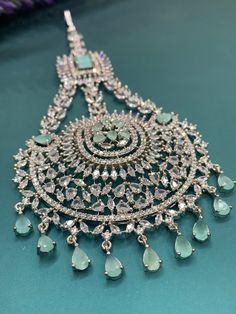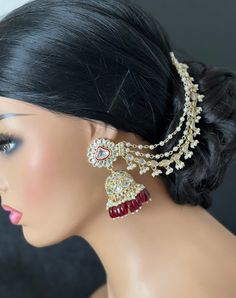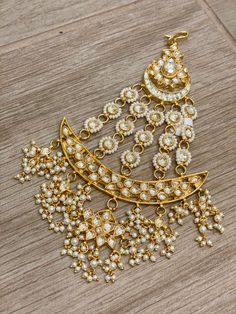Macrum Jhumar
Macramé jhumar is a traditional craft that has found its way into contemporary fashion design, blending intricate knotting techniques with modern aesthetics. This class note explores the art of macramé jhumar in fashion, covering its history, techniques, materials used, design applications, contemporary interpretations, and practical insights for fashion designers interested in incorporating this versatile craft into their collections.
Historical Context

Macramé, derived from Arabic and Turkish origins, gained popularity during the 1970s as a decorative art form for home decor and accessories. However, its origins trace back much further, with evidence of knotted textiles found in ancient civilizations across the globe, including China, Egypt, and South America. Jhumar, on the other hand, refers to ornamental hanging decorations traditionally used in South Asian cultures, particularly in weddings and festive occasions. The fusion of these two elements—macramé and jhumar—brings together intricate knotting techniques with the ornate and celebratory spirit of traditional adornments.
Techniques and Materials
1. Knotting Techniques:
- Square Knot: Basic knot used in macramé, formed by overlapping two strands and alternating to create a square pattern.
- Double Half Hitch: Creates diagonal and spiral patterns by looping one cord around another.
- Lark’s Head Knot: Secures cords to a mounting surface or hoop, often used as a starting point for macramé projects.
- Clove Hitch: Provides a sturdy knot for attaching cords and creating texture in designs.
2. Materials Used:
- Natural Fibres: Cotton, jute, hemp, and linen are commonly used for their natural look and texture.
- Synthetic Fibres: Nylon and polyester offer durability and flexibility, ideal for intricate designs and outdoor use.
- Beads and Embellishments: Incorporating beads, shells, or gemstones into macramé designs adds decorative elements and enhances visual interest.

Design Applications
1. Fashion Accessories:
- Earrings and Necklaces: Intricately knotted macramé patterns used to create lightweight and statement jewelry pieces.
- Belts and Bracelets: Wide or narrow bands of macramé used as belts or wrapped bracelets, often embellished with beads or charms.
2. Clothing Embellishments:
- Top and Dress Accents: Macramé appliqués or panels added to garments for a bohemian or tribal-inspired look.
- Swimsuit and Beachwear: Macramé details on swimsuits or cover-ups, enhancing beach and resort wear with texture and style.
3. Home Décor:
- Wall Hangings: Large-scale macramé designs used as decorative wall art, incorporating intricate knot patterns and fringe.
- Plant Hangers: Macramé plant holders or pot covers, combining functionality with aesthetic appeal in indoor gardening.
Contemporary Interpretations
In contemporary fashion, macramé jhumar has seen a resurgence in popularity due to its versatility and artisanal appeal:
1. Runway and High Fashion:
- Designer Collections: Macramé featured in haute couture collections, showcasing elaborate designs and craftsmanship.
- Statement Pieces: Oversized macramé accessories and garments make bold statements on the runway.
2. Bohemian and Festival Fashion:
- Boho-Chic Style: Macramé accents on clothing and accessories evoke a free-spirited and eclectic fashion sense.
- Music Festivals: Macramé garments and accessories popular among festival-goers for their handmade and artistic vibe.

3. Sustainable Fashion:
- Ethical Production: Handcrafted macramé promotes artisanal skills and sustainable practices in fashion.
- Upcycling: Using recycled materials and vintage fabrics in macramé designs aligns with eco-friendly fashion trends.
Practical Insights for Fashion Designers
1. Experimentation with Knots:
- Creative Freedom: Explore various knotting techniques to create unique patterns and textures.
- Trial and Error: Practice different knots and combinations to understand their visual impact and structural integrity.
2. Incorporating Color and Texture:
- Color Palette: Choose yarn or cord colors that complement the garment or accessory, enhancing its overall design.
- Texture Play: Combine different fibres or add beads and fringe to create tactile interest and visual depth.
3. Construction and Durability:
- Quality Materials: Use durable cords and yarns to ensure longevity and wearability of macramé pieces.
- Finishing Techniques: Secure knots and trim excess threads neatly to achieve a polished and professional finish.

Conclusion
Macramé jhumar in fashion design represents a harmonious blend of traditional craftsmanship and contemporary style. By mastering knotting techniques, exploring creative applications, and embracing sustainable practices, fashion designers can create unique and expressive pieces that resonate with artistic flair and cultural richness. As the fashion industry continues to evolve, macramé offers a timeless and versatile medium for creating handmade, artisanal fashion that celebrates individuality and creativity. Integrating macramé jhumar into fashion collections not only honors its cultural roots but also inspires innovation and connection in the global fashion community.
